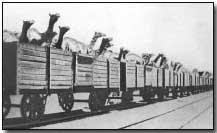Battles - The Battle of Mughar Ridge, 1917
 Having demolished the
Turkish lines at the Third
Battle of Gaza in late October/early November 1917 newly-installed
British Commander-in-Chief
Sir
Edmund Allenby continued his autumn offensive en route to Jerusalem (and
under instructions by
Lloyd
George to ensure its fall by Christmas) by dealing with the danger to
his inland flank posed by the Turkish Seventh Army while simultaneously
capturing the village of El Mughar.
Having demolished the
Turkish lines at the Third
Battle of Gaza in late October/early November 1917 newly-installed
British Commander-in-Chief
Sir
Edmund Allenby continued his autumn offensive en route to Jerusalem (and
under instructions by
Lloyd
George to ensure its fall by Christmas) by dealing with the danger to
his inland flank posed by the Turkish Seventh Army while simultaneously
capturing the village of El Mughar.
Led by Fevsi Pasha the Turkish Seventh Army had been dispatched across the desert by recently appointed Turkish regional commander Erich von Falkenhayn (the former German army Chief of Staff) in spite of advice to the contrary by his own staff officers.
Allenby's response was to continue his assault on coastal positions defended by the Turkish Eighth Army under Kress von Kressenstein (the man who had earlier thrown back two earlier British assaults upon Gaza). He meanwhile instructed the Australian Mounted Division to guard his force's flank in what comprised a somewhat thin of defence.
Consequently British infantry divisions launched an attack upon a ridge northwest of Junction Station (where the railway joined the Haifa-Jerusalem line) on 13 November 1917.
Difficult terrain around El Mughar slowed the advance before a charge by 800 cavalry troops - assisted by artillery and machine gunnery - cleared El Mughar by evening. Some 1,400 Turkish troops had been lost during the encounter, set against 616 British losses.
Next day British armoured cars entered Junction Station, succeeding in cutting off communication between the Turkish Seventh and Eighth Armies. Kressenstein's force was meanwhile pushed back beyond Jaffa.
While the attack at El Mughar was being conducted the Australian Mounted Division had managed to slow the advance of the Turkish Seventh Army. Clearly seeking a breakthrough Fevsi's force succeeded in pushing the Australians back several kilometres but the Allied line nevertheless held.
Fevsi finally determined to withdraw his army to cover the approaches to Jerusalem, which Allenby after a pause captured the following month.
Click here to view a map detailing actions fought during 1917.
Photograph courtesy of Photos of the Great War website
A 'flying pig' was a mortar bomb.
- Did you know?
